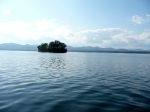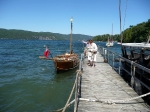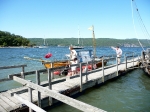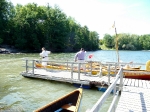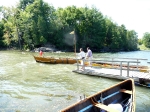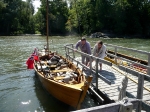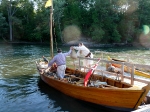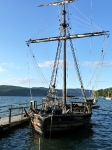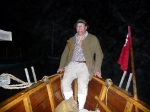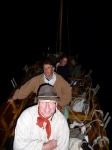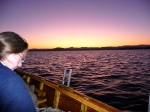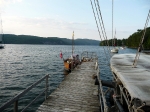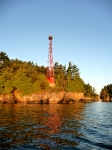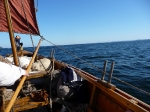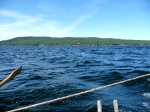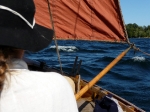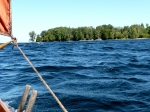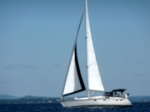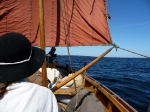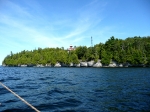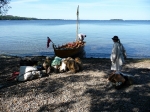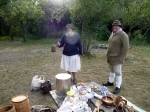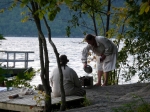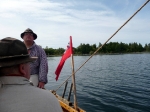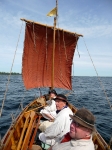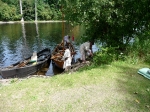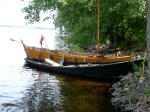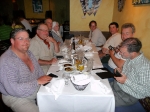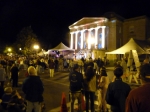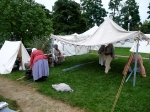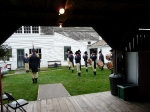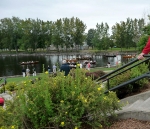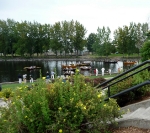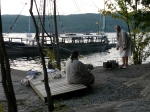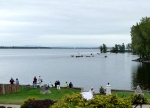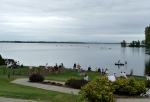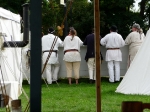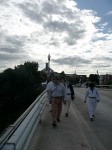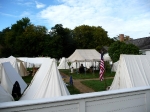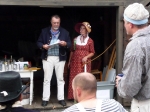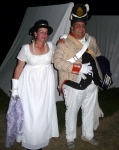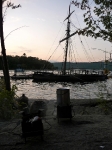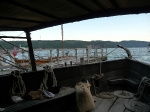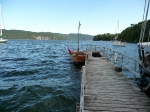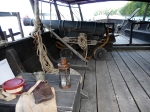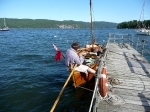Also known as ‘The Big Row, 2009’
All photos and text are by and copyrighted to William Manthey.
The Big Row in 2009 included only one boat: the Mabee Farm’s 23-foot bateau, Bobbie G, newly fitted with a swivel gun in the bow. We had a crew of four: David M., Kevin R-M., Rebecca M., and myself, Bill M.. David, as he did for the previous six annual Big Rows, did a great job setting up the row and was ably backed by Kevin in keeping the boat in shape and dragging it around by trailer. We travelled on Lake Champlain for four days (September 8 to 11) from Chimney Point to Plattsburgh, ending up in time for the re-enactment of the Battle of Plattsburgh of September 11, 1814. Since Schuyler’s/Second Albany re-enacts the French and Indian War and the Revolutionary War, it was a departure from our usual rut to re-enact an event in the War of 1812. We hopefully figured that bateaumen’s clothes and equipment changed little enough in the intervening years that we could make the transition. The re-enactment, on September 12 and 13, involved another dozen or so small boats, including the other Mabee Farm bateau, DeSager, crewed by other members of our unit.
Another switch from previous years was that we didn’t use our tents, even though we brought ’em along. The drawback of being unexpectedly held up by the wind on our second day out was more than made up by the good fortune of a favorable wind the following day.
Tuesday, September 8:
Rebecca and I got to the put-in place at 9:37 AM and were the first of the rowing group to arrive. The launching place was Chimney Point, Vermont, right under the eastern approach to the bridge over Lake Champlain that extends to Crown Point in New York. David and Kevin arrived in good spirits an hour and a half or so later after being held up by problems with their trailer hitch. We pushed off about 12:15 and headed north. We rowed steadily and ate lunch on the boat during one of the spells when we were under sail. The lake was beautiful and the weather was perfect.
With only a very little help from the sail, we rowed to North Harbor, where the Lake Champlain Maritime Museum (LCMM) has a dock to which the Philadelphia II (a replica of a 54-foot, 29-ton gundeloe in Benedict Arnold’s fleet, sunk by enemy action in 1776) and LCMM’s other boats are moored, arriving about 5:30 in the late afternoon. Even when sailing today, we usually supplemented the wind power by rowing. Crew: David steered, Kevin pulled stroke oar, I was next forward, and Rebecca was nearest the bow. That meant that Reb hoisted the sail when needed and used the boat hook as a whisker boom when under sail.
As we rowed into North harbor, we were met by Dale H. and Chris MacL., the latter playing the bagpipes as greeting. We moored the Bobbie G at the same pier as the Philadelphia II, which had its awning spread over its framework, shading the after part of the ship except for the aftermost part of the quarterdeck. Dale gave us permission to sleep on the Phillie and left the rest-rooms unlocked for us when he closed down the museum buildings and left for the night. David cooked chicken stew on a brazier for dinner. When we went to bed on the deck of the Philadelphia, there was a wind from the north or northwest and the stars were out, with a few clouds.
Even though the wind and waves were light, the Philadelphia and her fenders made a persistent creaking noise rubbing against the pier. The waves against the piers and boats sounded like distant voices. We became wakeful a few hours later when the noise got louder because the wind and waves had gradually increased. By sitting up in my bed on the Phillie‘s quarterdeck, I could see the Bobbie’s G mast waving back and forth against the sky, with its pennant fluttering. The moon lit up the sky, but our faces were shielded by the canopy over the deck where we lay. I alternated between being awake and asleep, with the wind gradually rising and the noises increasing.
Distance travelled today: about 13 miles.
Wednesday, September 9:
We had planned to get a fairly early start, hoping to push off by 8 AM. But by the time we got up, the wind was strong from the north or northwest, the boats were working at their moorings, and it didn’t look promising for rowing north. Kevin cooked breakfast and we sat there trying to decide about going. As time passed, the museum staff arrived and we swung toward deciding not to try to fight the winds. As Kevin said, gazing north, “I wanta be rowing — but not rowing out there.”
At least we had the satisfaction of being in the best possible locale to be windbound. We spent time either on the dock, talking with Samantha, a new staff member stationed on the Philadelphia to explain it to visitors, or wandering through the upper museum buildings and talking to Dale and other staff members. In the afternoon, David and Rebecca warped the Bobbie G from her mooring place opposite the Philadelphia around the end of the same pier, where she was less exposed to the waves.
David cooked beef stew for dinner. The forecast was for the wind to fall off completely by midnight, followed by light southerly winds, gradually increasing to moderate southerly winds later on Thursday. We decided to start as early as we could. To save the time we usually spend on breakfast, we boiled ten or so hen’s eggs and brewed a pot of coffee for tomorrow. We bedded down on the Philadelphia again, about 8:30, with the northwest wind still blowing hard and the boats making a lot of noise. We were wakeful at first, and it seemed like the wind and waves would never calm down. Eventually we fell asleep.
Distance traveled today: nil.
Thursday, September 10:
I woke up about half past midnight because of the silence. The wind was gone and so were the waves. I got dressed, paid a last visit to the rest room (thin-soled moccasins on the long rocky path up to the museum provide a vivid memory), and came back to the Phillie to crawl back into my sleeping bag in my clothes. I slept a bit more and woke up again about 3:35. Faint noises suggested that Kevin was prowling around. The world was lit up by the half-moon, except under the ship’s awning.
I got up and started packing my belongings. I heard Rebecca stirring, and pretty soon she whispered something about waking up David, who was still snoring gently. Our noises woke him up a minute or two later and presently we were stowing our gear in the Bobbie G. We climbed in, unmoored, and set off into the moonlit lake at 4:25.
The stars were few because of the moonlight, but we could see Orion and Sirius and a few other stars. An occasional shooting star appeared. There was no sign of any other boat. We could see the mountains outlined against the horizon, especially the Adirondacks in the west. Lights could be seen in a few houses along the shore, as well as navigational lights here and there. There was no noise except what we made rowing.
After a mile or two, we stopped rowing and drifted so that we could eat breakfast. David used the steering oar to keep us pointed north, and a very light south wind slowly pushed us in the right direction. Rebecca passed the hard-boiled eggs to us others. Kevin and Rebecca each had a cup of cold coffee, spiked with a tot of rum. David, after some hesitation, had part of a cup of cold coffee. They all agreed it tasted really bad. I drank water.
We went back to rowing (Kevin faster than before, I suppose because of caffeine). After we passed the Narrows, we were on the New York side of the lake. The south wind very gradually came up until we started talking about hoisting sail. New York law says that a vessel under sail has to show a light at the masthead at night until half an hour before sunrise, whereas a rowed vessel requires no light. By this time it was only thirty-five minutes short of sunrise, so we decided to wait five minutes and do without the candle-lantern that we had for the masthead.
After Rebecca hoisted sail, we glided along slowly. The wind speed varied, but we mostly could keep our oars in the “bank oars” position. The dawn appeared as a rosy glow behind the hills on the Vermont shore. The balance between moonlight and dawn-light gradually shifted, replacing the greys of the lake and shore with subtle dark blue and green. The time for sunrise came and we watched the sun pop up from behind the hills in Vermont like a giant bubble rising to the surface of a liquid. Indescribably beautiful.
The light and the wind speed increased together. We shipped the oars and Kevin and I turned to face forward. Rebecca had to adjust the whisker boom carefully to keep the windward clew trimmed to make best use of the wind. From time to time, she and David requested minor changes in the sheets, and David kept us on course with the steering oar.
As the day wore on, the wind got even stronger, with sizeable waves from astern, mostly on the starboard quarter, but sometimes on the larboard quarter. It was exhilarating to feel the breeze and look out over the pure, cool deep-blue waters with waves rushing forward and breaking into white-caps.
Working the whisker boom and steering became harder and required constant attention, with the steering oar pressing to one side or the other as the waves came and went. The troughs between the waves passing under the bow from behind seemed like steep precipices that the boat must fall from to bury herself in the next wave, while the waves from aft almost seemed to threaten to break over the stern. At Rebecca’s suggestion, we passed some of the heavier, more easily shifted cargo (water containers) aft to change the trim and bring the bow higher. This had the desired effect and made the boat easier to handle. If the wind and waves had been any stronger, we would have started to worry.
As we had hoped from the weather forecast, we passed by the possible stopover sites on the Vermont shore where we had at first intended to spend the previous night and bore ahead toward Valcour Island. By ten o’clock in the morning we were sure that we would succeed in making up for our lost day.
We set our course between the New York shore and Schuyler’s Island (Phillip Schuyler had a supply depot there). The water in the passage was much less wavy, and the water we encountered after we passed through and continued northwards continued to be so. The sailing became easier, but we kept going pleasantly fast.
I’ll skip the houses and towns and most of the other things we saw along the shore. A tall framework that seemed at first like a beacon later proved to be furnished with tumbled sticks in the upper regions and must be a platform for ospreys to use for nesting. A large old multiengine prop plane, maybe a DC3, passed overhead. We passed Burlington on the far shore to the east and saw ferry boats crossing the lake. There were only a few sailboats and other boats out on the lake.
Eventually we came into view of Plattsburgh ahead to our left and Valcour Island ahead to our right. There was no need to pack three days’ itinerary into one and proceed to Plattsburgh, so we bore up to Valcour Island, where we intended to camp at one of the public campsites along the shore. We sailed along the island’s west shore from south to north, looking for campsites. After a while, we found an attractive landing place and ran the boat up on a shingle beach. We tied the boat to nearby trees and carried our eatments and camping gear to the campsite, which consisted of a picnic bench in a field of trodden grass bordered by trees (many of them old apple trees run wild), scrub, and coarse grass. There was plenty of poison ivy, the promised outhouse was found only with difficulty, and previous campers had left scraps of debris and more.
The ground was hard enough that tent stakes couldn’t be pounded in, so we decided to sleep under the stars. David cooked ham stew, and everyone was well fed. We went to bed early and slept soundly despite the moon (I didn’t notice many mosquitoes or other pests). The air was pretty cool when we turned in but seemed to get a little warmer by morning.
Distance traveled today: about 35 miles. This is the farthest either of the Mabee Farm bateaux ever went in one day.
Friday, September 11:
We woke up pretty late and had a leisurely breakfast cooked by Kevin. After washing the dishes and pots, we loaded up the boat and pushed off. We went all the way to the west shore under sail and entered the Saranac River, which flows out of Plattsburgh, where we finally had to start rowing again. A third of a mile up the river, we came upon the Major Eyre tied up near a boat-launching ramp on the south bank next to a water-treatment plant. We tied up next to it and got out and stretched our legs.
Distance travelled today: about 6 miles.
Distance travelled on Big Row 2009: about 54 miles.
The others went off to find out what we needed to do next, leaving me to guard the boat. The Major Eyre didn’t need guarding, since it had so much water in it that it rested on the bottom. It had a big yellow ball in it (a marker buoy for the boat race on Saturday). David, Rebecca, and Kevin crossed the river to the north side on a small suspension footbridge to where the event was to be held.
Eventually they came back and we rowed the Bobbie G to the opposite bank and tied her up there. Rebecca and Kevin found somebody to take them back to Chimney Point by road so that Rebecca could get her car and Kevin could get his truck and the Mabee Farm’s boat trailer. David and I went to the barn behind the Kent-Delord House and talked to Craig R., who was in charge of things. He welcomed us and showed us where we could set up our tents.
Next came the hard part. David and I conveyed (portaged?) all the gear for the four rowers from the boat to the tent site at the Kent-Delord House. This involved getting it from the boat to the bank, carrying it along the bank, up a rock step about four feet high, through the edge of a park, up a long staircase made out of square wooden beams and dirt, a block down the street, and over a wall surrounding the yard.
After we were almost finished, Rebecca and Kevin got back. Then the crew of the second Mabee Farm bateau (the DeSager) arrived. They were Harvey A., Rick R., and Vic F., all fellow members of Schuyler’s/Second Albany. Then Katie (my wife) arrived from New Hampshire, bringing our tent and other impedimenta, as well as enough food to supply both boat crews, plus. She was travelling in her re-enactor’s outfit, slightly modified in hopes of matching 1814.
We set up all our tents and moved things around. Some of the DeSager crew had also brought the No. 3 dining fly and a supply tent, both of which came in very handy once the lack of parts for the fly was corrected. Before finishing setting up the last few things, we all walked downtown to find a place to eat. The town was swarming with people (in a small-town way) for the commemoration of the 195th anniversary of the Battle of Plattsburgh. David very generously treated the crew of the Bobbie G to a tasty elegant restaurant meal, and we all had a good time.
While the rest of ’em straggled back to camp, Katie and I stayed downtown a while to listen to the U.S. Navy Band Northeast. When the next act came on, we returned to camp and finished setting up equipment. There were also fireworks. Very weary to bed.
Saturday, September 12:
A busy day. Main features: At ten in the morning, we participated in a boat race, including about thirteen boats. The Bobbie G was our main entry, rowed by Reb, David, Harvey, and Rick and steered by me. The DeSager was our spoiler entry and was rowed by Vic (using two oars) and steered by Kevin. After jockeying for position at the mouth of the river, all the boats took off at a signal from a small cannon on shore, passed to the right of a yellow buoy near the point, then to a green buoy some distance (half a mile?) off the river mouth, around it to the right and back to the starting line. The General Arnold and another boat (the Chubb) soon took the lead, with the Bobbie G close behind. That group of three stayed ahead over the entire course, with some changes in spacing. After we rounded the green buoy and started home, the DeSager inexplicably wandered off its outward course and appeared to be an impediment for the first two boats on their inward course. “NO, NO, Kevin, don’t plow into the Arnold!” I muttered, aghast. At the last moment, the DeSager turned aside as the two lead boats slewed apart to evade the inexplicable wanderer. Strangely enough, the DeSager avoided getting into the path of the Bobbie G, which gained some on the two lead boats as a result of all these maneuvers. The rest of the field remained safely behind.
The end result was no surprise. The General Arnold, ably manned by Scott P. and his crew, came in first, with the Chubb, very creditably manned by only two men, both rowing, second, and the Bobbie G third. The errant DeSager was second to last. The Rooster, which had repeatedly won previous years’ boat races, was out of the money, presumably because of interference from some more inexplicably wandering boats.
At one o’clock in the afternoon, a battle was held between the boats, about equally divided into American and British, in the same area outside the mouth of the Saranac River. Of course, our little boats weren’t much like the four large vessels in each of the American and British fleets involved the 1814 battle, along with numerous gunboats. A large crowd watched from the point dominated by the Samuel de Champlain monument while Keith Herkalo narrated.
The DeSager was in the American fleet, with Harvey as gunner, Rick as rower, and me as steersman. The Bobbie G was in the British fleet, with Kevin as gunner, David as steersman, and Reb and Vic as rowers. This marked the first trial of the Bobbie G‘s newly mounted gun, and it turned out to be a peach. One of the American boats was anchored a little to the left of center, with the DeSager and one other boat ranging to her left. Rick was successful in maintaining us in station by rowing to advance and pull back as needed, while I kept the DeSager aligned so that her nonexistent broadside faced the enemy. Harvey accordingly fired the swivel gun mostly to one side. This was supposed to mimic the original tactics of the American ships. The British boats milled around in a pattern that I couldn’t figure out and eventually started cutting thru the American line. It seemed pretty chaotic, but nobody got hurt for real.
A few hours later, there was a big parade. It went past the Kent-Delord House and we got a good view. The biggest hit was the “Lawn-Chair Ladies.”
At five o’clock, the staff put on a big feed for the re-enactors in the camping area. It was good.
At or after eight o’clock, Reb emerged from her tent in her elegant and beautiful new gown. With gloves and all the other fashionable (in 1814) accoutrements, she was escorted by Todd E. to the Macomb Ball, where they enjoyed English country dancing. Katie fed pie to us and anybody else that seemed to be hungry. Some of the rest of the crew went to the dance too.
Sunday, September 13:
At or before 10:30 AM a mob of us walked to the City Hall and viewed the recovered anchor of HMS Confiance and listened to an interesting talk by Bill Van Stockum. Then we crossed to the Macdonough Monument, topped by a 22-foot bronze eagle, on the other side of the street. Some of us climbed to the top of the stairs inside the 135-foot obelisk.
At one o’clock, we redid yesterday’s battle off the mouth of the Saranac River. This time the DeSager was rowed by Vic and Harvey, with Rick acting as gunner and me again steering. Ann was added to the crew of the Bobbie G. The maneuvering by the British fleet was more controlled this time and a lot of powder was again burned.
Right after the battle, we brought our boats back to their mooring places and went back to camp. We spent the rest of the time in Plattsburgh striking camp, loading cars and trucks and pulling boats out of the water.
It was a very enjoyable event. The organizers did an outstanding job and everybody had a good time.

